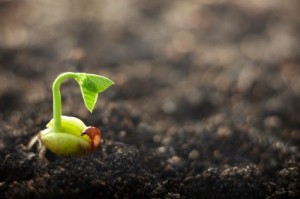 Most vegetable and flower seeds will freely germinate when given water, the ideal temperature, and a loose, well-aerated growing medium. Other seeds, however, need special treatment before they can be coaxed into germinating. These "pre-treatments" may include such things exposure to cold, or a thorough washing from rain.
Most vegetable and flower seeds will freely germinate when given water, the ideal temperature, and a loose, well-aerated growing medium. Other seeds, however, need special treatment before they can be coaxed into germinating. These "pre-treatments" may include such things exposure to cold, or a thorough washing from rain.
Just imagine what would happen if every seed in a given population of plants germinated at the same time and suddenly there was a killing frost. The end result would be disaster. These extra conditions are built-in safety mechanisms that ensure seeds wait out the winter (or in some cases the dry season) before they sprout. And since not all seeds will have their extra conditions met at the same time, germination rates are staggered and the overall risk to the species is reduced.
Native seeds don't necessarily need to be pre-treated to germinate. Pre-treating them just increases the odds of success and helps speed up the process.
Other seeds may benefit from soaking because their thick seeds coats are hard for water to penetrate. In the vegetable garden, seeds like beets, carrots, parsley, parsnips, and spinach can all benefit from soaking. Size has nothing to do with whether a seed should be pre-soaked or not. It's all about the seed coating.
Small seeds can be folded into a biodegradable coffee filter, moistened with water, and placed into a plastic bag. Allow them to dry again before planting (they will stick to the filter), then cut up the filter into small pieces and plant the seeds, filter and all, directly into the soil. Note: If your seed package doesn't direct you to pre-soak the seeds, don't bother.
For example, Morning Glories seeds can benefit from this process. To do this, gently rub the seeds back and forth a few times between two sheets of sandpaper. With larger seeds, you can also use a nail clippers or a small nail file to carefully chip away a small portion of the seed coat. Be careful not to grind the seeds into dust or cut completely through to the embryonic portion in the seed.
In a controlled environment, you can mimic moist stratification by placing seeds in a plastic bag or re-sealable container with an equal volume of moist (not wet) sawdust or clean builder's sand. Place the bags in the refrigerator at 34 to 38 degrees F for at least 3 to 4 weeks (do NOT freeze them). Try to time your moist-stratification treatment so that your seeds come out of the refrigerator at the appropriate time for planting.